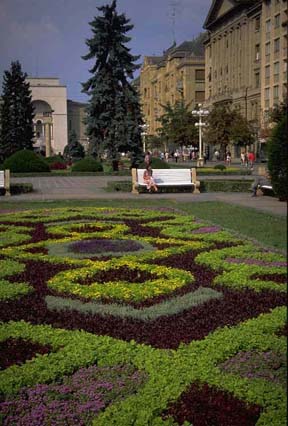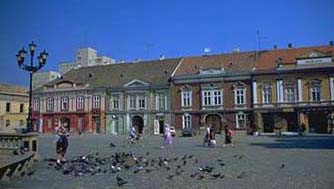 Timisoara is at the far west of Romania, near the borders of Hungary and Yugoslavia. An ancient Roman fortress, once called Castrum Temesiensis, its records date back to 1212. In 1214 it was destroyed by Tatars. A century later, under Hungarian domination it took the name Temesvar. In the 15th century the city was rebuilt and enlarged by governor Iancu de Hunedoara and years of prosperity followed. The Turks invaded in 1552 and ruled until they were finally driven out in 1716 by Eugeniu de Savoia. This time the region became part of the Habsburgs' Austro-Hungarian empire, beginning a progressive era which lasted 200 years.
Timisoara is at the far west of Romania, near the borders of Hungary and Yugoslavia. An ancient Roman fortress, once called Castrum Temesiensis, its records date back to 1212. In 1214 it was destroyed by Tatars. A century later, under Hungarian domination it took the name Temesvar. In the 15th century the city was rebuilt and enlarged by governor Iancu de Hunedoara and years of prosperity followed. The Turks invaded in 1552 and ruled until they were finally driven out in 1716 by Eugeniu de Savoia. This time the region became part of the Habsburgs' Austro-Hungarian empire, beginning a progressive era which lasted 200 years.
Timisoara's greatest claim to fame may be its role as the catalyst of the December 1989 revolution which, within 10 days, overthrew Romania's communist dictatorship. It was here on Dec. 15th that a Hungarian minority began protesting the exile of popular Calvinist
pastor Laszlo Tokes for his criticism of the government.
Timisoara is called the "garden city" with good reason. Flower gardens appear everywhere. There is even a large clock made of flowers in the park next to the Hotel Continental.
Elegant baroque buildings line Piata Victoriei; the promenade is filled with cafes, bookstores, shops and cinemas, manicured gardens and park benches.
At breaks in the garden are fountains and sculptures including the Romulus and Remus statue, a gift from Rome.
At the south end of the piata, across the street, stands the towering Orthodox Cathedral, founded during the reign of King Michael I,
Banatul Philharmonic resides one block east of the cathedral.
At the north end are the Opera House and the National Theatre.
East of the Opera stands Hunyadi Castle, erected by King Charles Robert of Anjou in 1318 and restored by Iancu de Hunedoara, Voivode of Transylvania. It is now home to the Museum of Banat
A block north of the Opera, along pedestrianized Strada Alba Iulia, is Piata Libertatii, a small green square with flower gardens and park benches. Across the street is the Old Town Hall, built in 1734 in the Renaissance style
 Piata Unirii is a huge grand square surrounded by gems of architectural design. Buildings painted blue, green, gold, and dark red are trimmed with white & beige stripes, window frames and ornamentation. They include, the Catholic Cathedral (1748), which holds services in German; the smaller Serbian Orthodox Cathedral (1734); and the Museum of Fine Arts.
Piata Unirii is a huge grand square surrounded by gems of architectural design. Buildings painted blue, green, gold, and dark red are trimmed with white & beige stripes, window frames and ornamentation. They include, the Catholic Cathedral (1748), which holds services in German; the smaller Serbian Orthodox Cathedral (1734); and the Museum of Fine Arts.
In the piata’s center are fountains amid grassy plots and stone benches.
Due east of Piata Unirii, at Strada Popa Sapca 4, is the Ethnographic Museum displaying folk costumes and illustrations of regional ethnic diversity . Southeast of Piata Unirii , is the huge
Dicasterial Palace. It was built for the Habsburg government and has 450 rooms in neo-Renaissance style.
Timisoara was settled on the northern bank of the Bega river, which was canalized. Gustave Eiffel built a bridge across the river. Take a stroll along its banks or through Parc Central next to the Orthodox Cathedral. South of the canal is Romania’s fourth largest university. The city now has 326,000 people, many of them students.
 A World of Adventure
A World of Adventure  A World of Adventure
A World of Adventure